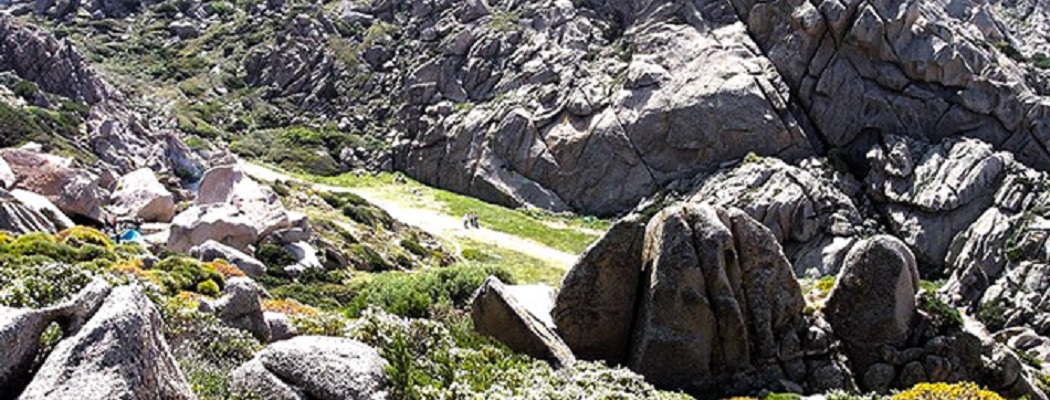
The Valley of the Moon is a small beach area in Santa Teresa Gallura (SS), that resembles a lunar landscape, located near Capo Testa in the southern part of the narrow isthmus formed by the beaches of Santa Reparata and Rina di Ponente and the granite cliffs that are typical for this area. It is accessed by a path along the coast, which winds through small natural caves, tafoni, a source of fresh water, and a primary forest of oaks, juniper, arbutus, myrtle and heather. The southern coast of Corsica can be seen from the beach.

During the 1970s, this area was a favorite for hippies who set up camps within the valley to enable themselves to connect with nature. The landscape is breathtaking; enormous granite formations that have been carved by the mountain winds into fantastic shapes, jut from the earth like giant men along with other rock formations that have been rendered smooth over the years. The real show comes at night, when the white boulders glow under the moonlight.
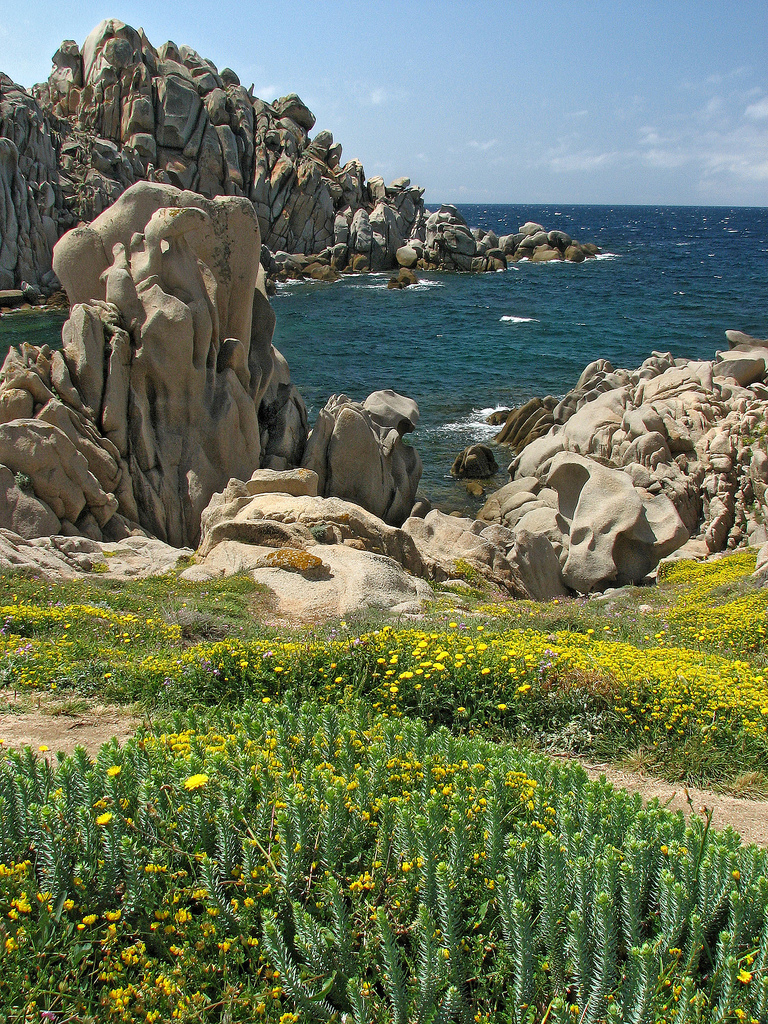
The vegetation is mostly scrub; heather and wild myrtle stick out between the rocks and tall thin grasses blow in the wind, adding their own influence on the unusual landscape. The valley leads down to the sea where the waves batter the cliffs but, despite this turbulence, the feeling is always of calm. The beaches are narrow with white sand. Visually they are a stark contrast to the rugged landscape of the valley. It is also an area where you can relax on a hot day in one of the secluded coves.
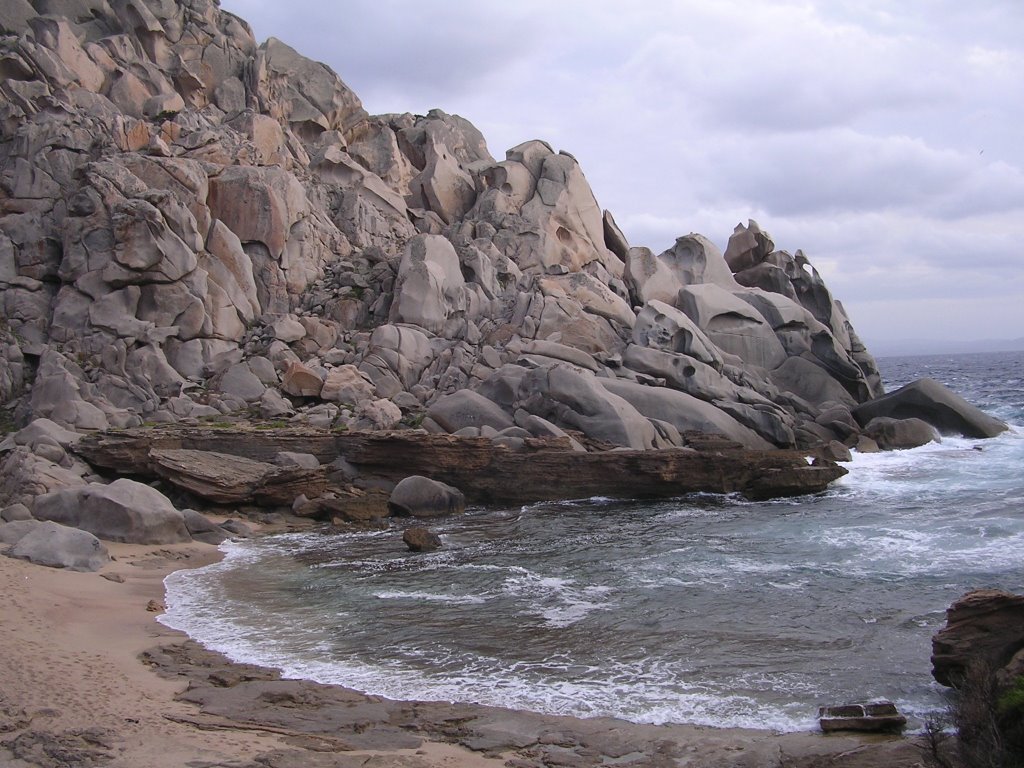
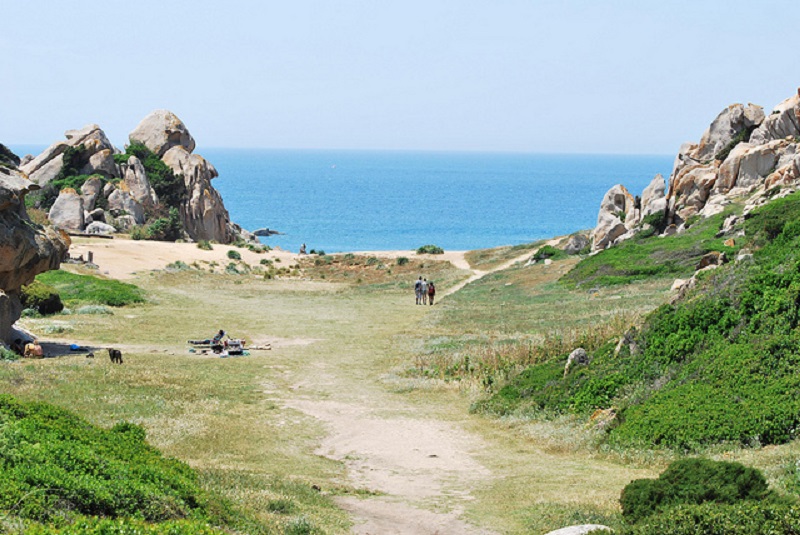
The island’s geography gives some visual clues as to how influential other cultures have been in helping to shape Sardinia’s fascinating food culture over the course of the its invasion-riddled history. Considered a Mediterranean island, Sardinia’s eastern coast touches the Tyrrhenian Sea. While unquestionably an Italian region, Sardinia’s closest neighbor is actually the French island of Corsica to its north. On Sardinia’s southern coast, the shores of Algeria and Tunisia are closer even than Sardinia’s sister island, Sicily. Add to its unusual geography, the island has a long history of living under the rule of the Phoenicians, Romans, Vandals, Arabs and Spanish (just to name a few). They are one of only two groups of Italian peoples recognized as poplo (or “distinct people”), who carefully preserved their own language – Sardinian – elements of which pre-date the Latin roots it shares with the Italian language.
Walk the valley in this video.
Wild boar, lamb, pork, eggplant, artichokes, tomatoes, lobsters, sea urchins, octopus, clams, mussels and squid are all part of the Sardinian cuisine. Salty, “acquired-taste” signature flavors have developed, like those of bottarga (pressed and salted mullet roe) and the globally recognizable island namesake and mainstay, sardines. Carta di musica (or “sheet of music,” a favorite paper-thin crisp bread baked to a relatively dry state) graces almost every table. Traditional hearty Italian pastas like culingiones (ravioli) share center stage with Arabic-inspired couscous dishes. Cheeses hold a special place in Sardinia, being the island’s most exported food product.
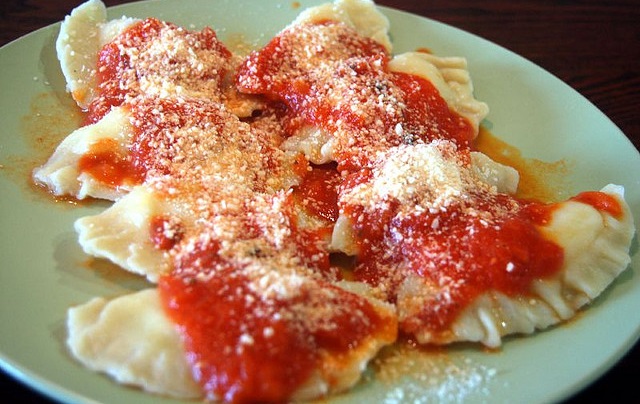
Culurgiones (Sardinian Potato Ravioli)
Culurgiones are traditionally served on All Saints’ Day.
Pasta
- 2 cups plus 2 1/2 tablespoons semolina flour
- 2/3 cup water
- 1/2 teaspoon fine sea salt
Filling
- 1 pound Yukon Gold potatoes, peeled and cut into 1 1/2 inch pieces
- 1 cup grated Pecorino Romano
- 1 tablespoon extra virgin olive oil
- 15 mint leaves, minced
- 1 egg, lightly beaten
- Salt and pepper to taste
Brown Butter Sauce
- 1/2 stick unsalted butter
- Salt and pepper
- 2 ounces grated Pecorino Romano cheese
- 1 tablespoon finely minced mint leaves
Homemade Marinara Sauce
Directions
Make the pasta. Combine the semolina flour water and salt in a mixer with the paddle attachment. Mix on medium until smooth. Add a little more water if necessary.
Cover with a damp cloth and let the dough rest for 30 minutes.
Make the filling by steaming the potatoes until fork tender. While still warm mash them or use a ricer to make them smooth. Add the cheese, olive oil, mint and egg. Season with freshly ground pepper and salt.
Cut the dough into 3 sections. Put one piece of dough through the pasta machine roller until you have a thin smooth layer of pasta (around level 5 or 6.
Sprinkle the work surface with a little semolina flour, place the pasta sheet down and cut 4 ” circles out. Place a scant tablespoon of the filling on each circle. Fold the pasta so it looks like a taco and pinch it closed; crimp the edges together with the tines of a fork. Repeat the process with the remaining dough and filling.
Make the sauce by melting the butter over medium heat. Don’t let it burn. Lower the heat and keep warm.
Boil the pasta for 2 1/2 minutes. Use a slotted spoon to remove them from the water and arrange on a serving dish. Drizzle the brown butter sauce or marinara sauce over the culurgiones, sprinkle with some freshly grated cheese and top with minced mint leaves.
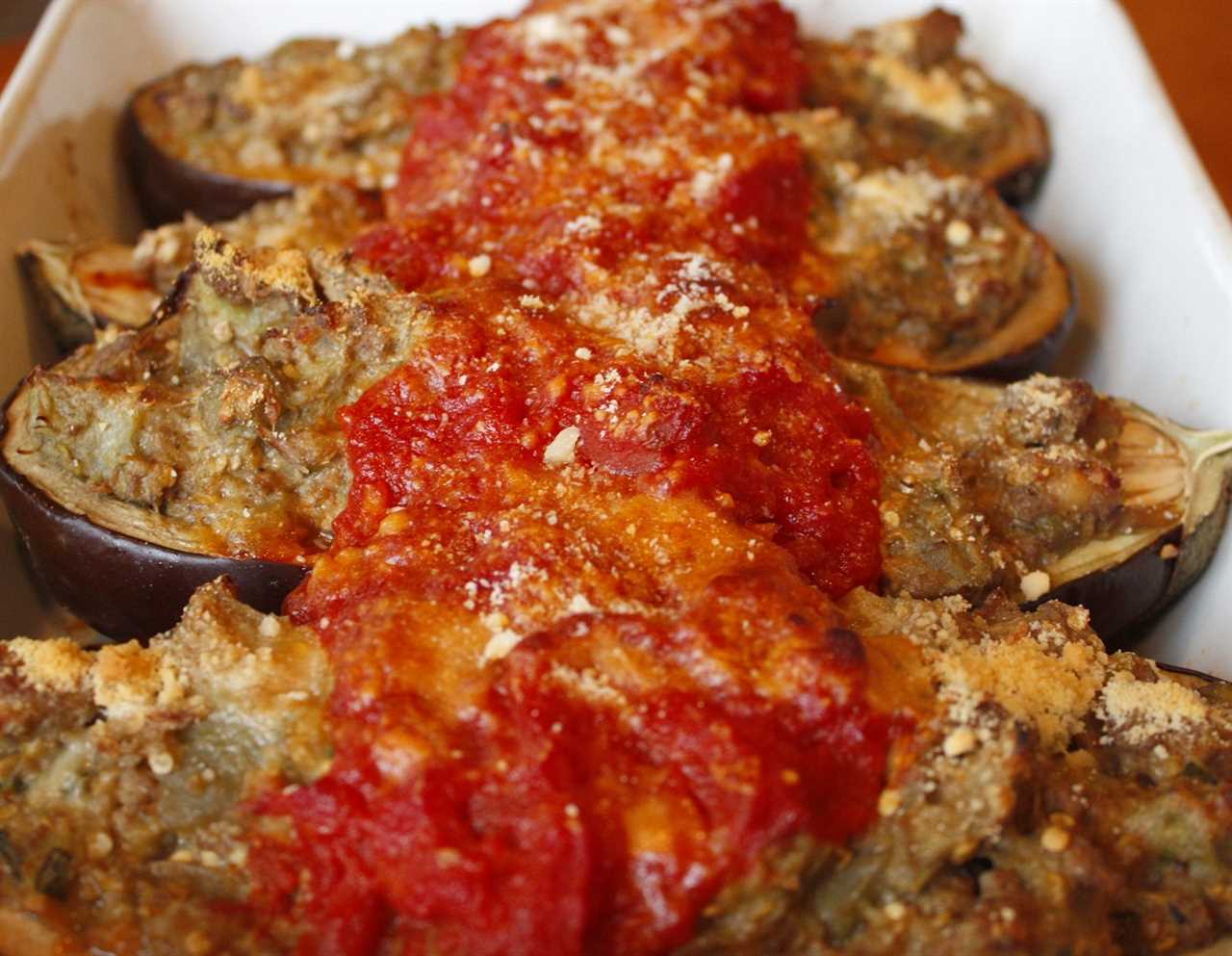
Sardinian Stuffed Eggplant
This dish tastes better the next day. The baked stuffed eggplant can be refrigerated overnight. Bring to room temperature, then reheat in a 325° F oven.
Ingredients
- Five 1-pound Italian eggplants,(2 whole; 3 halved lengthwise)
- Kosher salt
- Extra-virgin olive oil
- 1 medium white onion, finely chopped
- 2 small bay leaves, crushed to a powder
- 1/2 cup dry white wine
- 1/2 pound ground pork
- 1 cup freshly grated fresh pecorino cheese, preferably Fiore Sardo (4 ounces)
- 2 large eggs, lightly beaten
- 1/2 cup plain, dried bread crumbs
- Pinch of freshly grated nutmeg
- 1 tablespoon chopped basil
- 1 tablespoon chopped mint
- Freshly ground pepper
- 3 garlic cloves, thickly sliced
- One 35-ounce can Italian peeled tomatoes, drained and coarsely chopped
Directions
Peel the whole eggplants; coarsely chop their flesh and transfer to a large colander.
Using a spoon, scoop the flesh from the 6 eggplant halves, leaving a 1/4-inch-thick shell. Set the shells aside.
Chop the scooped out eggplant flesh and add it to the colander with the other eggplant.
Mix the chopped eggplant with 2 tablespoons of kosher salt and let drain for 30 minutes, then rinse well. Working in handfuls, squeeze out as much of the water as possible. You should have about 4 cups of chopped eggplant.
Meanwhile, bring a large pot of salted water to a boil. Set a wire rack on a baking sheet.
Add the 6 eggplant shells to the pot and cook, gently poking them under to keep them submerged, until just tender, about 3 minutes. Using a slotted spoon, transfer the eggplant shells to the wire rack to drain and cool.
Lightly oil a 9-by-13-inch baking dish and arrange the eggplant shells in it, cut sides up.
In a large, deep skillet, heat 3 tablespoons of olive oil until shimmering. Add the onion and bay leaves and cook over moderate heat until the onion is softened, about 5 minutes. Add the chopped eggplant and wine and cook over moderate heat, stirring occasionally, until tender and just beginning to brown, 15 minutes. Add the pork and cook over moderately high heat, stirring and breaking up the meat, until cooked through and lightly browned, about 5 minutes longer.
Transfer the eggplant filling to a bowl and stir in 1/2 cup of the pecorino cheese, the eggs, bread crumbs, nutmeg, basil and mint. Season the filling with salt and pepper. Spoon the filling into the eggplant shells.
Preheat the oven to 350°F.
For the sauce: in a medium saucepan, heat 1 tablespoon of olive oil. Add the garlic and cook over moderate heat until golden, about 1 minute. Add the chopped tomatoes and cook over moderate heat, stirring, until thickened, about 10 minutes. Season with salt and pepper.
Spoon half of the sauce over the eggplants and sprinkle with the remaining 1/2 cup of grated pecorino cheese. Bake the eggplant until browned and bubbling, about 35 minutes. Let cool slightly, then serve, passing the remaining tomato sauce on the side.
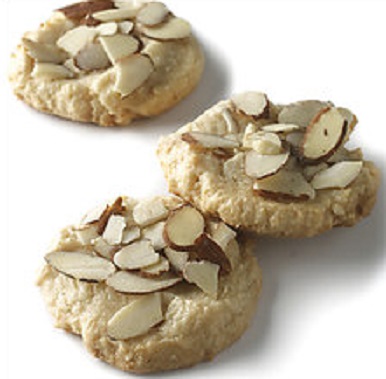
Sardinian Almond Cookies
30 Cookies
Ingredients
- 16 ounces almond paste
- 1 cup chopped almonds (with skins; not slivered)
- 2 large egg whites
- 1/2 cup confectioners’ sugar
Directions
Position oven racks in the middle and lower thirds of the oven; preheat to 300 degrees F. Line 2 large baking sheets with parchment paper or silicone liners.
Break up the almond paste into large chunks and place them in a food processor. Process briefly until the paste is finely chopped. Add 2/3 cup of the almonds, the egg whites, sugar and process until the mixture forms a thick, smooth paste.
Drop 1 scant tablespoon of dough onto the prepared baking sheets, spacing them at least 1 1/2 inches apart. Scatter the remaining chopped almonds over the top.
Bake for about 12 minutes, then rotate the sheets top to bottom and front to back. Bake for 12 to 13 minutes, until the cookies are light golden brown.
Let cool completely on the baking sheets before storing.
Related articles
- Italian Treasures – Lampedusa, Sicilia (jovinacooksitalian.com)
- https://jovinacooksitalian.wordpress.com/2014/03/21/italian-treasures-sardinias-living-art-gallery/
- https://jovinacooksitalian.wordpress.com/2013/02/08/the-cuisine-of-italy-sardinia/
Title: Italian Treasures – Moon Valley Sardinia
Sourced From: jovinacooksitalian.com/2014/10/31/italian-treasures-moon-valley-sardinia/
Published Date: Fri, 31 Oct 2014 12:35:06 +0000
Frequently Asked Questions
What should I be eating in a Mediterranean day?
Healthy fats and proteins are key to a Mediterranean diet. There is also a lot of fresh fruits and vegetables. A healthy Mediterranean diet should include about seven to 10 servings of fruits and vegetables daily and two to four 3-ounce servings of lean protein such as fish or chicken. In moderate quantities, nuts and olive oil are good sources of healthy fats. To ensure a balanced diet, aim for three portions of whole grains each day, such as quinoa or barley.
Also, it is important to limit foods that are unhealthy when consumed frequently. These include all processed foods and added sugars, unhealthy fats as well as white bread, starches and sweetened drinks such sodas or juices. It is important to avoid dairy, and to consume reduced-fat milk when possible. Fish should not be consumed beyond three times per week because of potential mercury contamination issues affecting its nutritional value if overlooked during meal planning stages.
To ensure you're getting the most from your Mediterranean diet experience every day, it can help to plan meals - paying particular attention to ingredients included within chosen dishes that provide the heart and health benefits associated with this dietary pattern accordingly over time.
A Mediterranean diet is a great way to enjoy a healthy and delicious lifestyle. You can eat high-quality protein such as wild-caught and grass-fed fish, organic eggs, and meat, in order to have the best meals. Incorporate heart-healthy fats like nuts, avocados and extra virgin Olive oil. Include plenty of fresh and/or freeze fruits and vegetables, whole grains like quinoa and barley in your meals, as well as whole grains such oats, quinoa and barley. Also, avoid unhealthy fats and added sugar as well as processed foods, starches red meat, and processed milk products.
Is Banana permitted in the Mediterranean diet?
Yes, bananas are allowed in the Mediterranean diet. Bananas can be a healthy, low-calorie, nutritious fruit that provides vitamin B6 and potassium. It can be used as a side dish or added to meals such as porridge, smoothies and salads. To add protein, it can be served as a snack along with nut butters such as almond and peanut. It may be beneficial to combine fruits like bananas with healthy fats such as nuts and seeds when following the Mediterranean diet. This will improve digestion and increase satisfaction while eating throughout the day.
What foods can you not eat on a Mediterranean diet
The Mediterranean diet prohibits certain food groups including processed foods and added sugar. Certain foods shouldn't be eaten to maintain the health benefits associated with this dietary pattern. Consuming these items occasionally can still be part of a healthy diet, but consistently eating them can counteract the potential health benefits of following a Mediterranean eating plan.
The Mediterranean diet prohibits whole-grain breads as well as starches, including white bread, sugary cereals, breads made from refined flours, and any other high-processed baked goods. These items are rapidly absorbed as sugars into your system and can cause weight increase over time. They also lack vitamins and minerals as compared to whole grains like quinoa and millet.
Other forms of sugar also fall into this category. As such, limit your intake soda, tea with additional sugars, and juices. These sweetened drinks won't support weight control or healthy nutrient profiles.
It is best to avoid red meats and processed foods in Mediterranean-style meal plans. Red meats as well as processed meats are high in saturated fats. This raises the risk of heart disease and other metabolic syndrome-related illnesses. Due to the association of nitrates with cell damage responses within the cells, processed lunchmeats may raise cancer risk. Dairy products should be avoided as many cheeses have high levels of saturated fats.
According to nutrition experts, fish should not be eaten more than three times per week.
What is a Mediterranean breakfast?
A Mediterranean breakfast might include a mix of protein, healthy oils, and carbohydrates. Options can range from eggs cooked in olive oil with a side of roasted vegetables or a salad, Greek yogurt or cheese served with whole-grain toast, or quinoa porridge topped with fresh fruits, nuts, and seeds. Avocado toast is a wonderful option for breakfast. Begin your day on the Mediterranean with high-quality proteins like wild-caught seafood, grass-fed beef, organic eggs and nuts. Choose nutritious carbohydrates such as whole grains like quinoa and oats; limit sugar by opting for fresh fruits instead of sweetened yogurts or cereals; add healthy fats to your meal such as avocado, extra virgin olive oil, olives, and coconut oil; and supplement your breakfast with some green tea for added antioxidants.
Is the Mediterranean diet primarily plant-based?
Yes, the Mediterranean Diet consists primarily of plants. This ancient diet is primarily based on plant-based foods, such as fruits and vegetables, legumes (nuts), and seeds. Red meat, poultry, and fish can also be found in smaller amounts due to their provenance around the Mediterranean Sea. You can choose to avoid these protein sources if you are a vegetarian/vegan. Tofu and soy yogurt are excellent options for additional nutrition and protein.
Statistics
- One small study suggested that swapping one-half of your serving of a high-glycemic starch (like rice) with lentils helps lower the glycemic response by 20 percent. (everydayhealth.com)
- Benefits of Replacing foods high in saturated fats (like butter) with plant sources high in monounsaturated fatty acids, like olive oil, may help lower the risk of heart disease by 19 percent, according to research. (everydayhealth.com)
- The Mediterranean Diet group had a 30% lower relative risk of cardiovascular events compared to the low-fat diet group. (my.clevelandclinic.org)
- Aim to get 20 to 35 percent of your total daily caloric intake from fat, and for saturated fats to represent less than 10 percent of your total caloric intake, advises the U.S. Department of Health and Human Services. (everydayhealth.com)
External Links
[TAG28]
- The Mediterranean Diet: From an Environment-Driven Food Culture to an Emerging Medical Prescription - PMC
- Definition of the Mediterranean Diet: A Literature Review - PMC
[TAG31]
- The Health Benefits of the Mediterranean Diet - PubMed
- PubMed: Cardiovascular Health and the Mediterranean Diet - PubMed
[TAG34]
- (PDF) The Association Between Dietary Patterns And Insulin Resistance: A Systematic Study
- (PDF). Citrus as a Mediterranean Diet Component
[TAG37]
How To
How to plan a week full of Mediterranean dishes that are both delicious and nutritious?
The Mediterranean diet is a great way to improve your health and lifestyle. This rich diet is high in healthy fats, whole grain, legumes and fresh fruits. This eating plan can provide many benefits such as better blood lipids, glucose control, lower risk of certain cancers and depression, better weight management, cognitive function, and better cardiac health.
Following these tips can make it easy to incorporate Mediterranean-inspired foods into your diet: swapping out high-calorie snacks like chips with nutrient-dense vegetable appetizers or other traditional greens or beans dishes; learning how to increase variety with spices or different sources derived from nuts, fruits, and vegetables; integrating more whole grains, legumes, and high fiber items that can enhance satiety after meals; adding moderate amounts of dairy products like yogurt cheese and milk throughout the day for added nutrition; using olive oil as the primary cooking fat instead of traditional oils; occasionally enjoying a glass of red wine to complete the Mediterranean experience.
For a week filled with delicious, healthy meals that fall within the Mediterranean diet guidelines, you will need to focus on specific ingredients. This could include protein, fish, poultry or eggs, as well as healthy fats like olive oil nuts and avocadoes. You may also want to consider vegetables in prepared vegetables salads dips spreads soups or vegetables, starches like potatoes, legumes, old grains, and others. ; fruits for desserts snacks smoothies, etc. Seasonings herbs, sauces and optional dairy yogurt cheese Kefir. You can mix up the flavors throughout the week to ensure adequate nutrient intake and flavor balance. This is an important element of a Mediterranean-style lifestyle. You will see even greater improvements in your body composition and health if you combine the meal with regular exercise.
Resources:
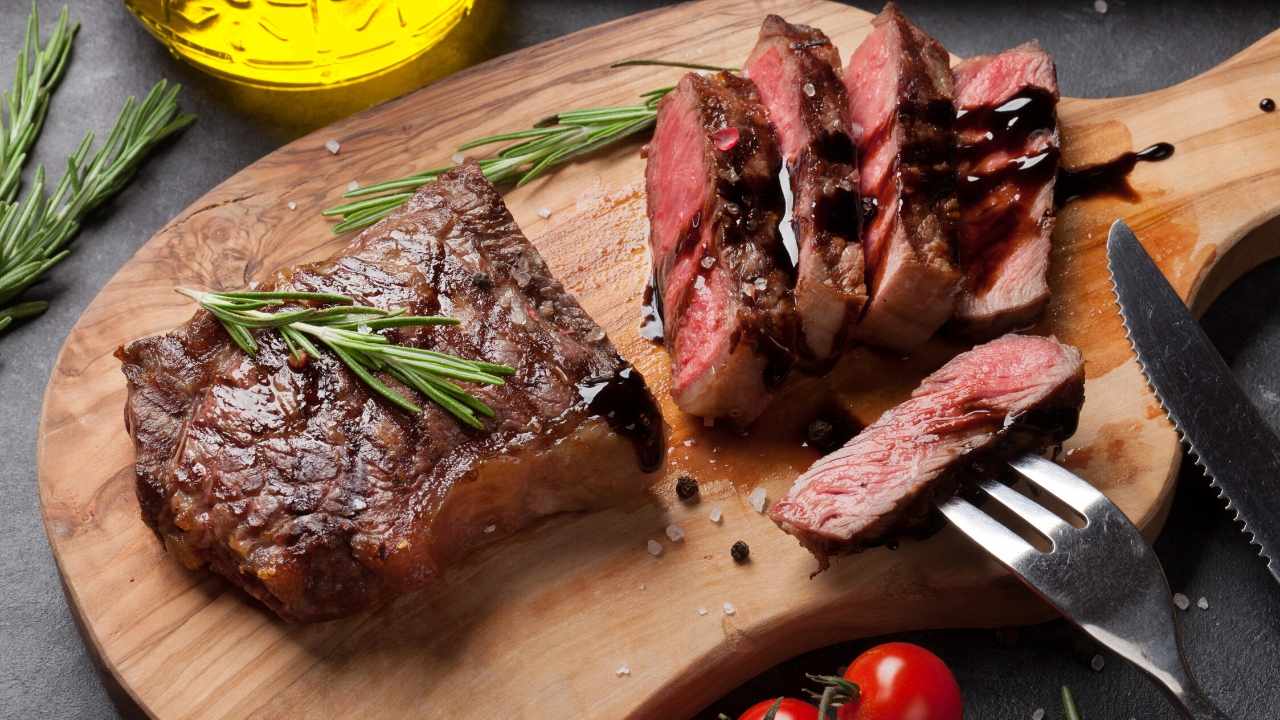 |
[TAG40]Healthline ranked the Mediterranean Diet number 1 for the following reasons: Numerous studies associate the Mediterranean diet with a reduced risk of heart |
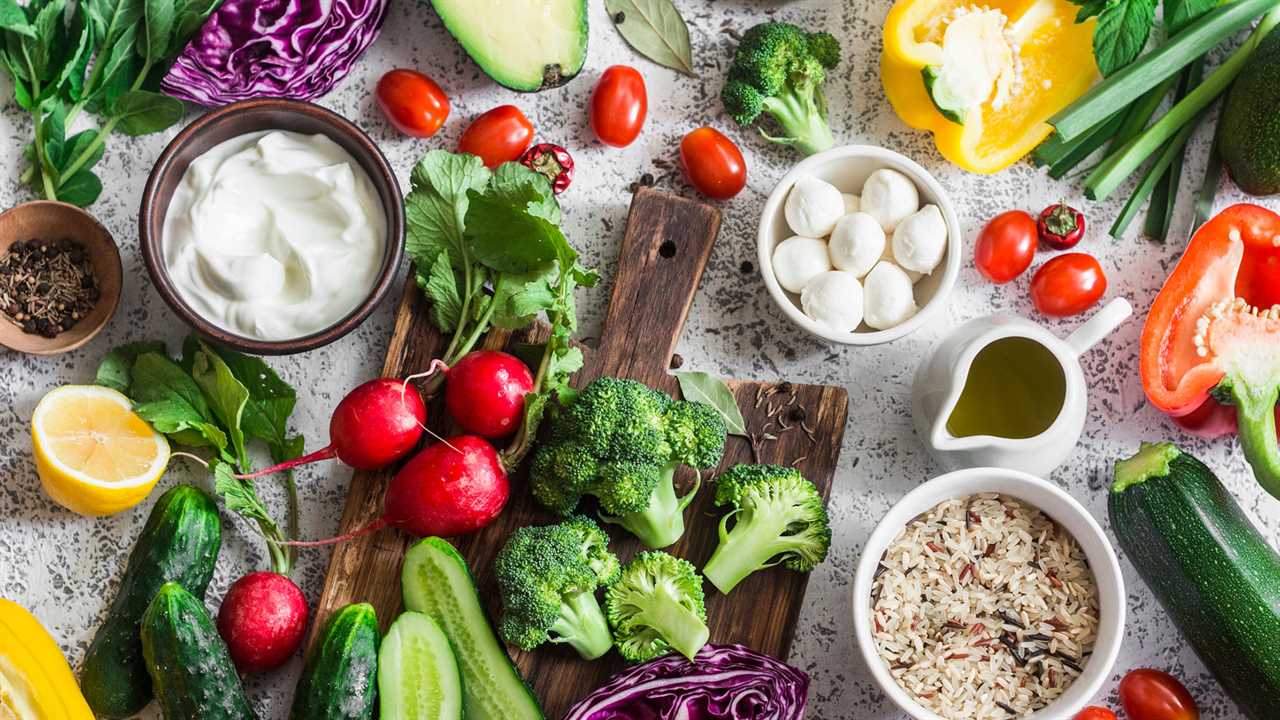 |
[TAG41]The Mediterranean diet originates in the food cultures of ancient civilizations which developed around the Mediterranean Basin and is based on the regular |
 |
[TAG42]Psychology Today reports: Eating more green, leafy vegetables and less red meat were associated with improved cognitive functioning in a recent study of older |
 |
[TAG43]This review of five human studies on the Mediterranean diet examines its effects on weight loss, various diseases, and the risk of death. |
 |
[TAG44]CNBC reports that Joan Salge Blake, Boston University’s clinical professor of nutrition says: “‘Poor protein [intake] can contribute to fatigue, and that’s the |
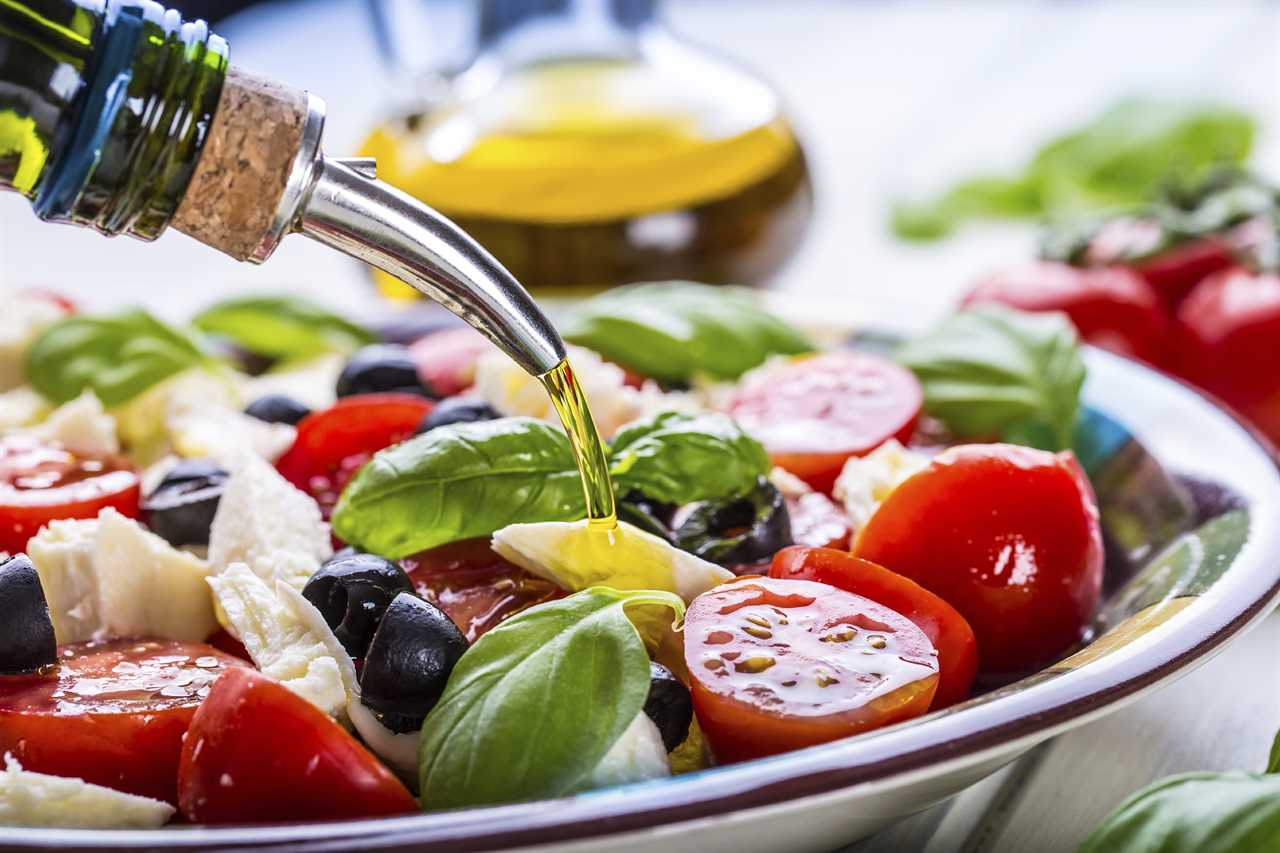 |
[TAG45]The Mediterranean diet has been linked to a number of health benefits, including reduced mortality risk and lower incidence of cardiovascular disease. |
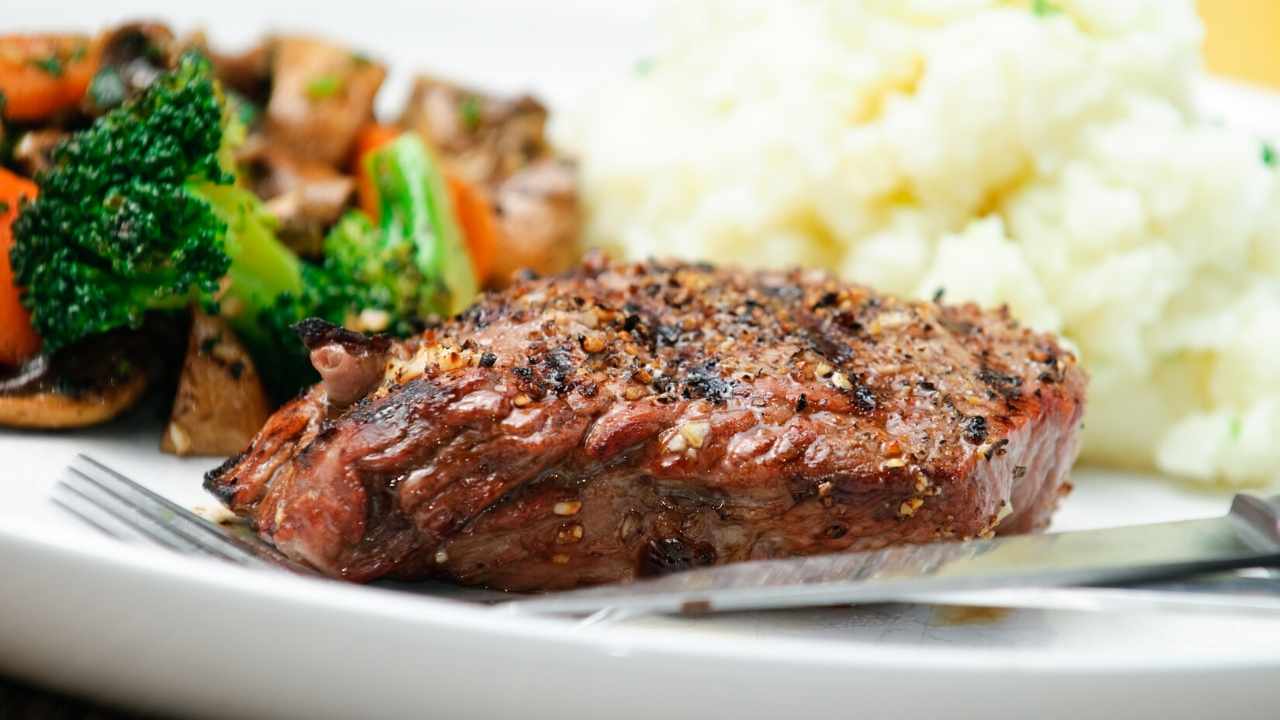 |
[TAG46]According to Olive Oil Times: The authors of the meta-study, published in Current Obesity Reports, noted that hypertension, type 2 diabetes mellitus, several |
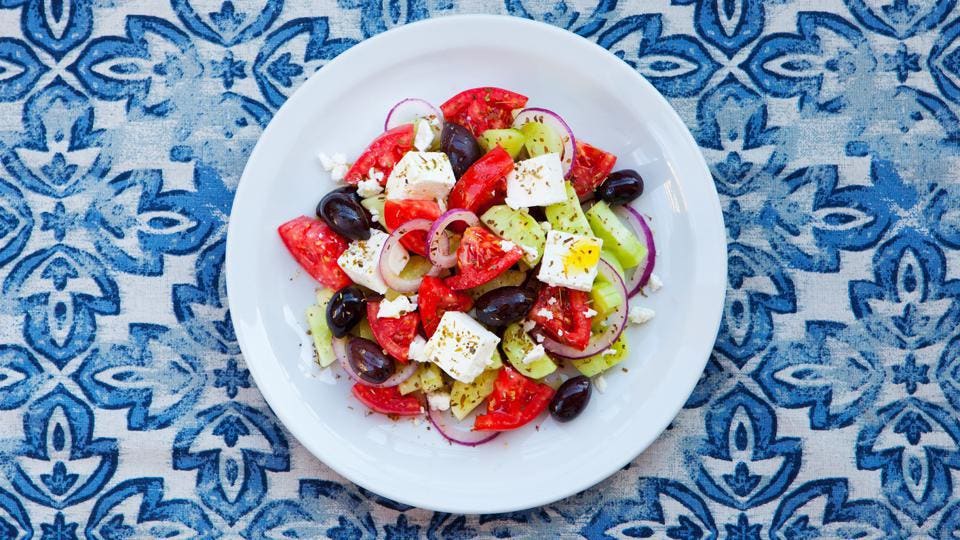 |
[TAG47]The Mediterranean diet, with its emphasis on fresh vegetables and fruit, whole grains, legumes, olive oil and fish, provides an array of health benefits, |
 |
[TAG48]The study described in The Epoch Times found: In the conclusions of this study, the authors prefer the Mediterranean diet over the Keto diet because the key to |
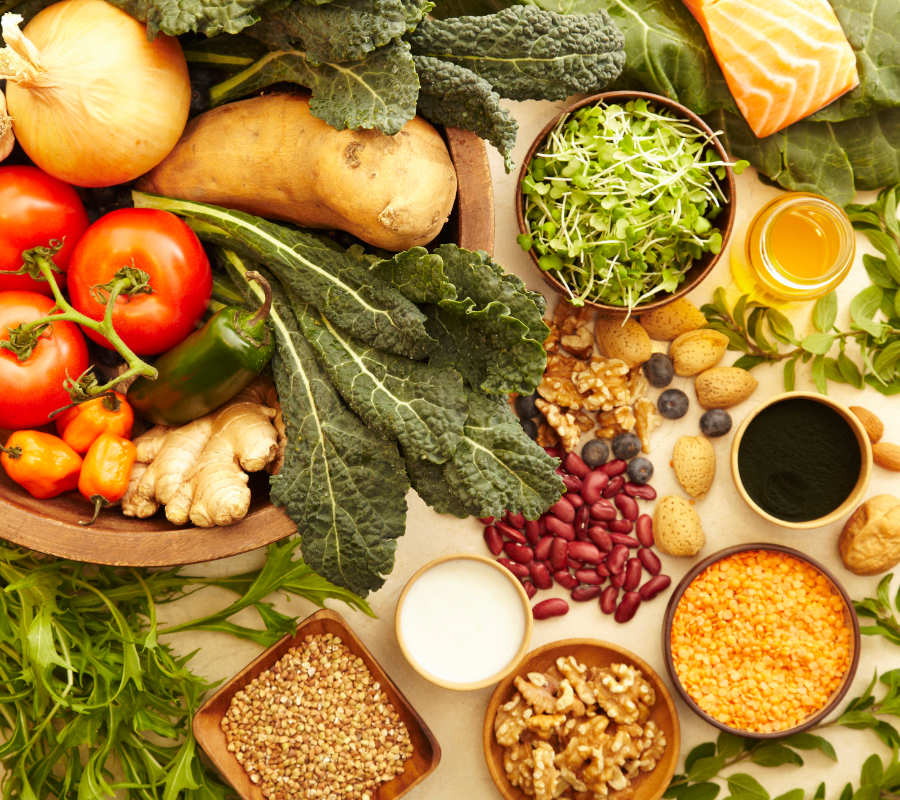 |
[TAG49]The Mediterranean diet is a heart-healthy eating plan that emphasizes healthy fats, whole grains, fruits, vegetables, beans, nuts and seeds. |
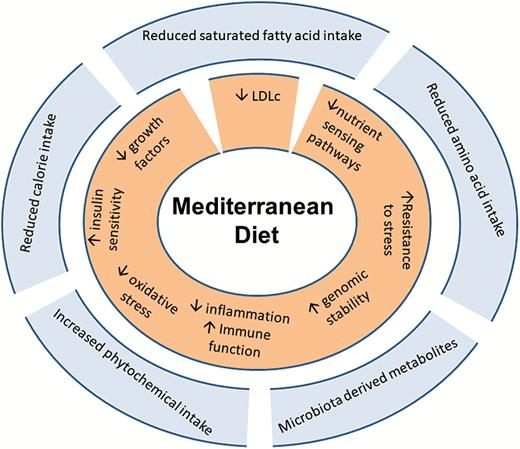 |
[TAG50]Abstract. Consuming a Mediterranean diet rich in minimally processed plant foods has been associated with a reduced risk of developing multiple chronic diseases |
 |
[TAG51]It’s an easy (and delicious!) change that can turn your diet into a disease-fighting tool. |
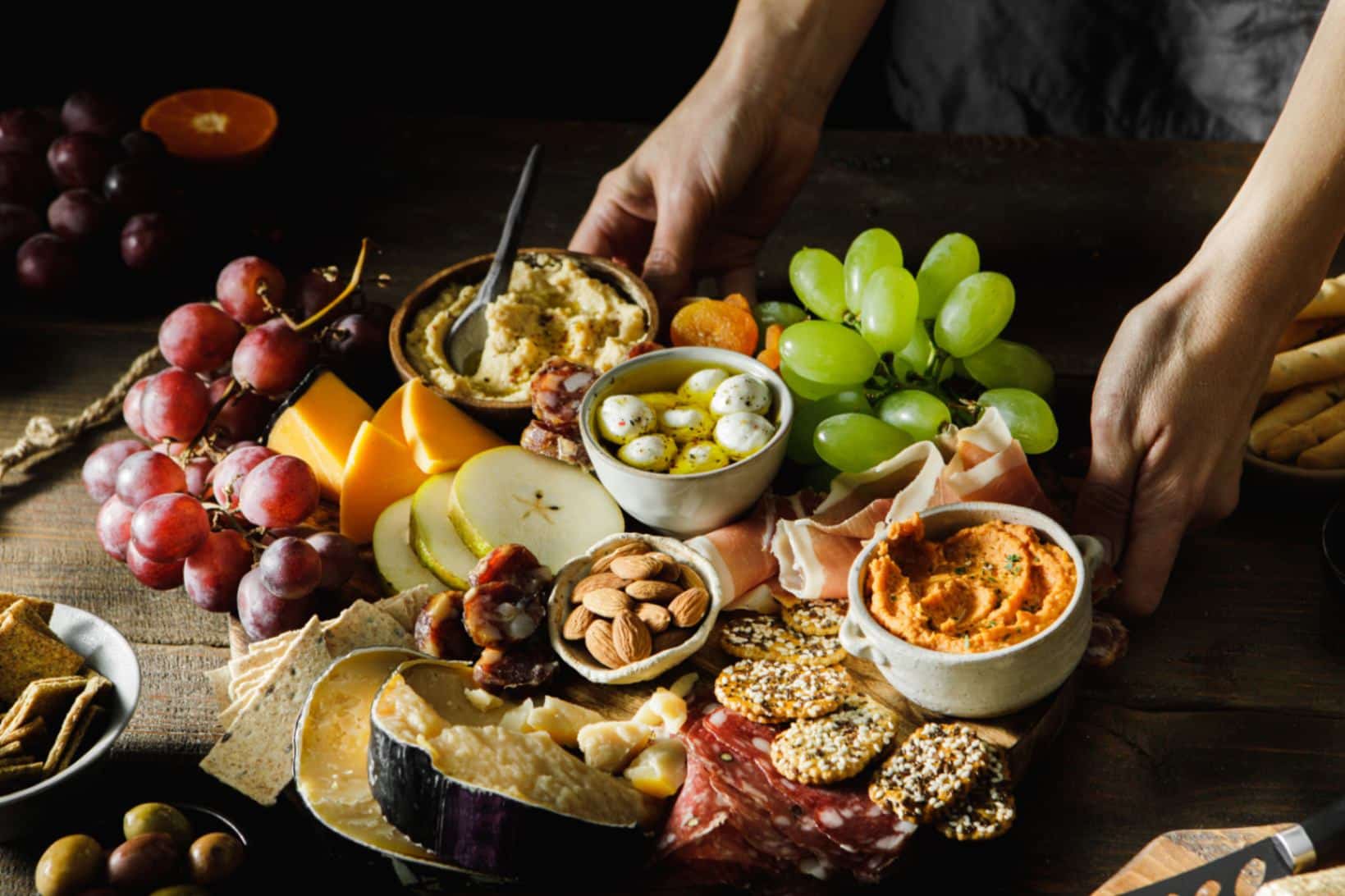 |
[TAG52]There are many misconceptions about the Mediterranean diet. Learn what it really means and how it can help you live a healthier, longer life. |
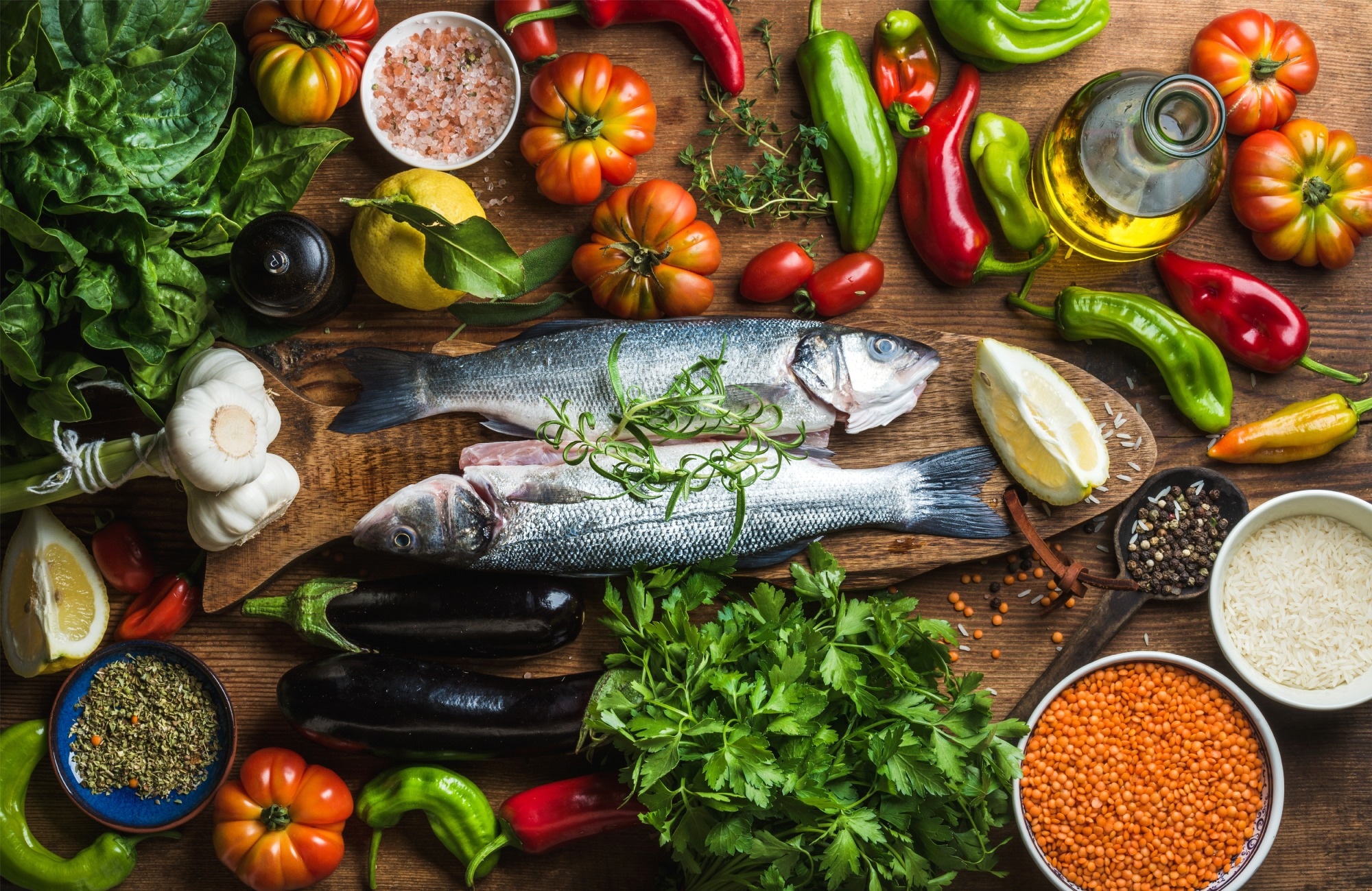 |
[TAG53]A review article published in the journal Experimental Gerontology describes the utility of Mediterranean diet (MedDiet) in the prevention and management of |






